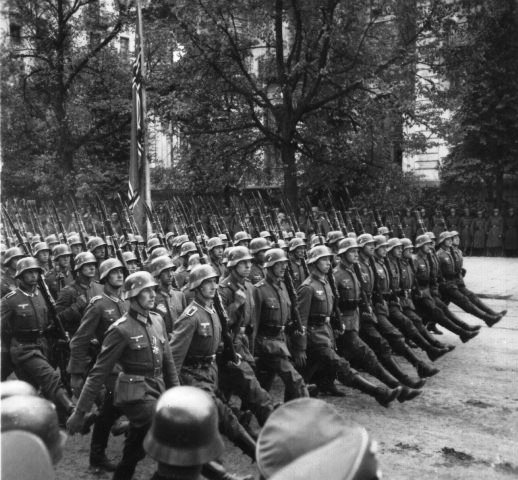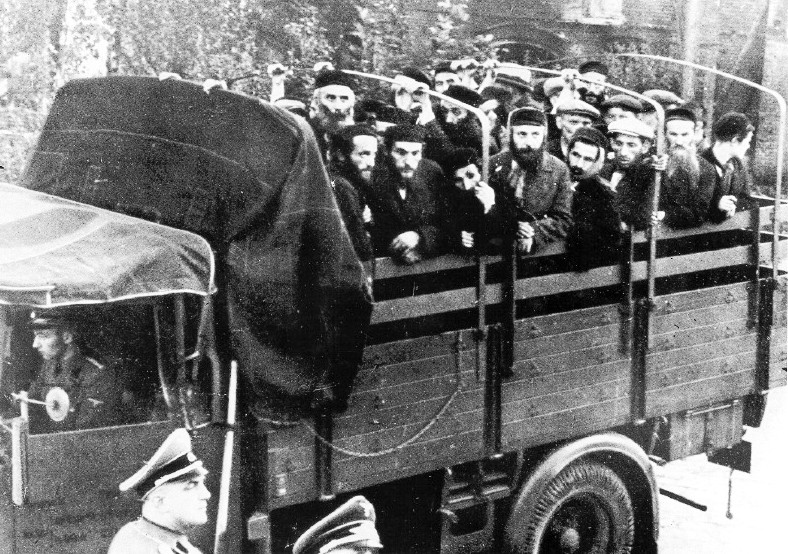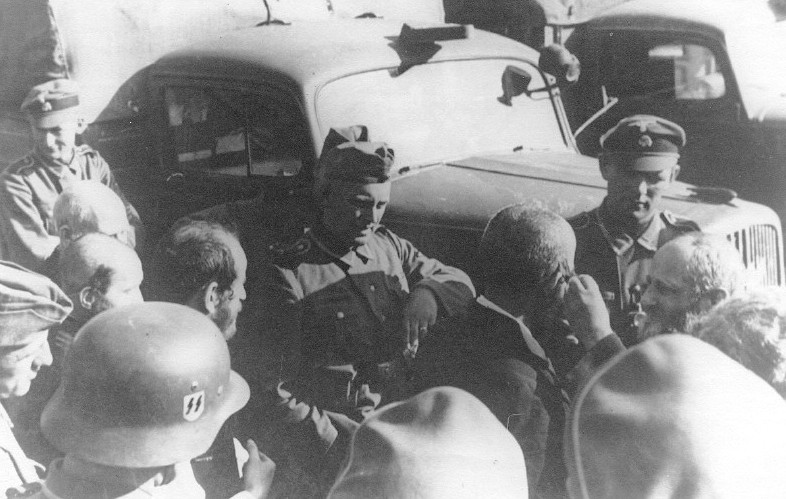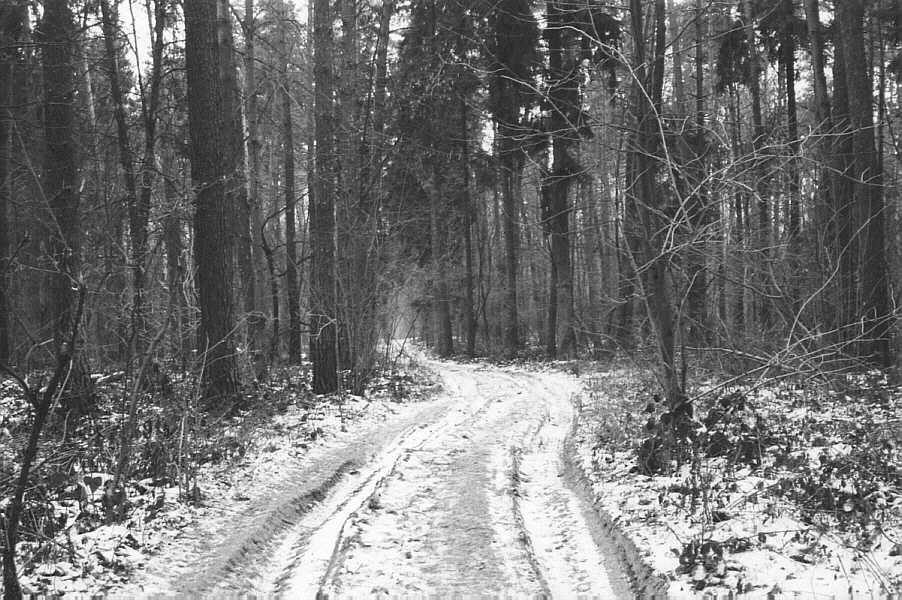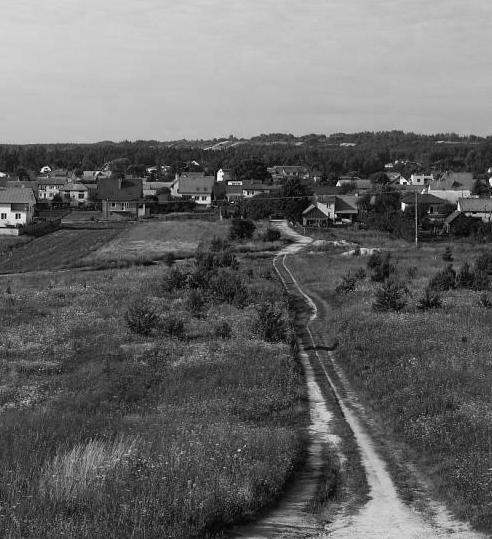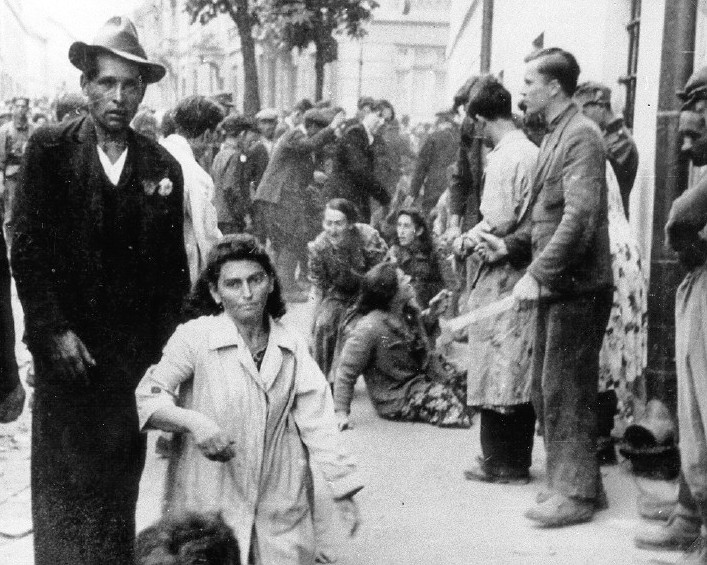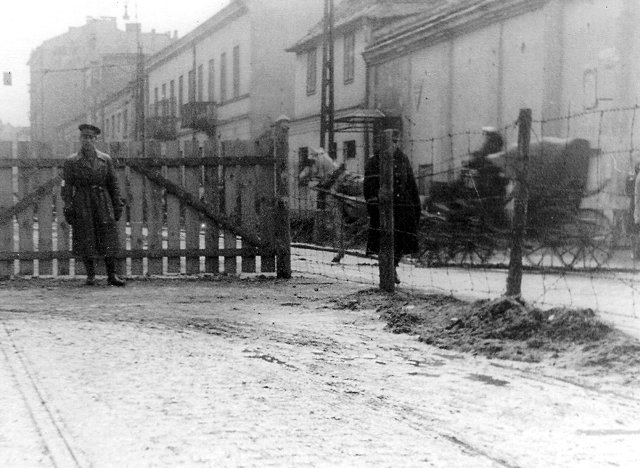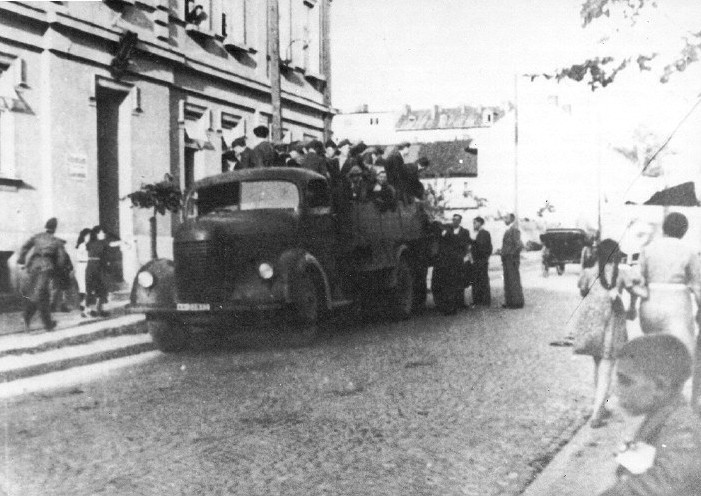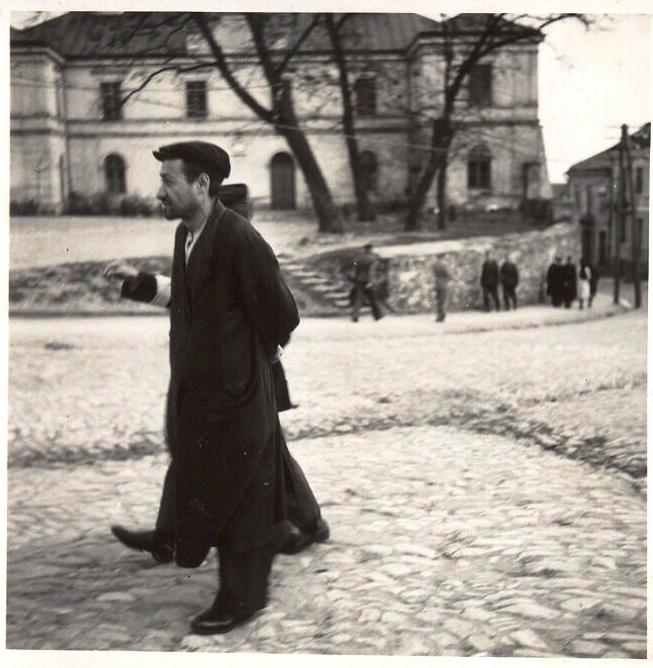Holocaust Education & Archive Research Team |
|
Occupation German Occupation of Europe Timeline
-
[The Occupied Nations]
Poland Austria Belgium Bulgaria Denmark France Germany Greece Hungary Italy Luxembourg The Netherlands Norway Romania Slovakia Soviet Union Sudetenland | |||||||
German Persecution of Jews in Poland From Cities to Villages – Widespread Terror
The German invasion and subsequent occupation of Poland triggered the persecution of the Polish and Jewish population. The mass murder and ill treatment of Jews was often carried out amidst scenes of utter barbarity and contempt for the Jews, whom the Germans regarded as Untermensch (sub-human).
Warsaw
On December 1 1939 the Krakauer Zeitung reported from Warsaw under the heading Polish Policeman murdered by Jews:
“A Polish policeman in uniform was shot while on duty on November 13 in Warsaw at Nalewki 9 by a Jewish gang. A second official was dangerously wounded by a shot.
The occupants of the house at Nalewki 9, hampered the search for the murderers, who had fled, by offering open resistance. In the meantime the police succeeded in tracing the murderer, a Jew and professional criminal, Pinkus Jankiel Zylbring, who on account of the war had been prematurely released from prison.
In his possession was found the weapon used for the murder. Because of their reprehensible conduct during the police investigations, fifty-three male Jews from the house, Nalewki 9, were shot.
When German soldiers attempted to loot the business of Stephen Luxemburg, a Jewish goldsmith in Warsaw, he shouted for help. The soldiers left, but others soon came to search the premises and found German rifle bullets, which of course, they themselves had brought. Luxemburg was then taken out and shot.
Mr Hoffman the proprietor of the Café Esplanade, and a well-known citizen was executed on a charge of sabotage which consisted in leaving his job when put on forced labour.
Lodz
Mary Berg who went from Warsaw to Lodz wrote in her diary, on the 2 November 1939 on what she saw when she looked out of her window:
“A man with markedly Semitic features was standing quietly on the sidewalk near the curb. A uniformed German approached him and apparently gave him an unreasonable order, for I could see that the poor fellow tried to explain something with an embarrassed expression.
Then a few other uniformed Germans came upon the scene and began to beat their victims with rubber truncheons. They called a cab and tried to push him into it, but he resisted vigorously.
The Germans then tied his legs together with a rope, attached the end of the rope to the cab from behind and ordered the driver to start. The unfortunate man’s struck the sharp stones of the pavement, dyeing them red with blood. Then the cab vanished down the street”.
Ostrow Mazowiecka
When a fire broke out in the town, the Jews were blamed, and all who remained – 600 men, women and children were taken to the outskirts and murdered.
Przemysl
Eight hundred Jews of Przemysl are said to have been led across the bridge to the German occupied part, where most of them were put to death.
Chelm & Hrubeiszow
Eighty-three Jews were shot between Chelm and Hrubieszow. They were part of a group of several hundred Jews driven out the two towns by the German military command. They were put to death, because when the Germans ordered them to run in the direction of the frontier of the Russian –occupied areas, they did not run fast enough.
Lask
In January 1940 German police officers boasted that during house searches in the small town of Lask, one hundred Jews were shot. Outside a synagogue in the same town a crowd of Jews tried to prevent the Germans from entering.
The Nazi police used their guns killing several hundred Jews. The synagogue was razed to the ground.
Pabianice
In Pabianice nine Jews and young Jewish women were flogged for refusing to salute the Nazi flag.
Laskarzew
German troops quartered in Laskarzew, a small town near Warsaw, were withdrawn much to the delight of the local population. However, several days later a squad of fourteen or fifteen German soldiers arrived and seized thirty-seven Jews, all of whom were led out of the town and shot.
Bedzin
In Bedzin the Germans crowded the Jews into the Jewish quarter and set it on fire. Many Jews perished in the fire, and those who went to their aid were shot down.
Krakow
During three days December 18 -20 1939 a general search was carried out in all the houses in Kazimierz, the Jewish quarter of Krakow. This search developed into a deadly pogrom, during which all shops, stocks of goods and private houses were looted.
The entire suburb was surrounded for these days by a cordon of Police and the plundered merchandise was carried away methodically and quickly in lorries. During the pogrom 180 Jews were tortured to death.
Plock
In January 1940, the German authorities in Plock conducted a group of Jews to the building of the Catholic Religious Seminary, ostensibly for the purpose of making the place tidy.
Then the Jews were attired in church vestments and were ordered to dance before sacred images. The Germans kicked these images about, ruining them and breaking them.
The Jew wearing the finest vestments was picked out and ordered to smash a bust of Christ and was given a hammer to work with. When the Jew hesitated, and, when threatened, fearfully aimed a blow at the head of the figure, one of the Germans swore at him, and told the others that he, the German, would show them how to smash heads. Using the butt-end of his rifle, he smashed the Jew’s head in.
Zelechow
On January 24 1940 three Jews in the village of Zelechow were stripped bare in twenty –five degrees centigrade of frost, then the Germans poured water over them and they were then ordered to run around a telephone post for half an hour.
Zdunska Wola
In Zdunska Wola the Germans collected forty Jews all over fifty years of age, in the market square, and forced them to strip and then to form two rows, face to face, crouching on the ground.
Then they were ordered to slap one another on the face. Those who did not hit hard enough were at once flogged. When all the Jews were covered with blood, they were made to race, and those who fell behind were flogged again.
Dora Rosenboim recalled another event in Zdunska Wola:
The Gestapo ordered the Jewish police to bring the ten Jews to a place where a gallows had already been prepared and the Jewish police had to hang the ten Jews with their own hands.
To add to this horrible, unheard of crime, the Gestapo drove all the Jews out of their houses to the hanging-place, so that all the Jews should witness the great catastrophe.
Many women fainted seeing the terrible and horrible sight, how ten of our brothers were writhing on the gallows. Our faces were ashamed and our hearts ached, but we could not help ourselves.
Nowy Sacz
At Nowy Sacz in Southern Poland members of the SS several times during December 1939, drove Jews dressed in ritual attire to the market place and ordered them to dance and jump. Those who resisted were beaten.
Pulawy
In Pulawy, at a temperature of 30 degrees Centigrade of frost, one night the Gestapo ordered the Jews to leave the town at once on foot, and they sprinkled them with water.
On the journey three old Jews froze to death, the others arrived at Opole at sunrise. In the afternoon the same Gestapo officers came and began again to torture the evicted men, beating them for two hours with whips.
Lublin
The Krepiecki forest is approximately 12 kilometres on the way to Zamosc, and during the Second World War, the Nazis carried out mass executions at this site.
On the 3 May 1940 the first execution took place in the Krepiecki forest, some 12 kilometres from Lublin, on the road to Zamosc. A group of Poles and Jews were executed as a reprisal for the murder of a functionary of the Lublin SD, a certain SS-Hauptsturmfuhrer Loska.
The biggest mass execution took place on the 21-22 April 1942 organised by the SS/SD in Lublin, following the conclusion of the deportations from the Lublin ghetto to the death camp in Belzec.
All the members of this group was incarcerated in two filthy barracks and subsequently taken by trucks in batches to the Krepiecki forest. The SS men told the prisoners that there was a big manor behind the forest where they would work in the fields.
Many of the prisoners believed what the SS –men told them, until they stood on the path leading to the forest and started to hear the shots and screams of the first batch of victims.
Jozefow
One of the executioners of Police Battalion 101 August Zorn described how he murdered a very old Jew in Jozefow in July 1942:
“His elderly victim could not or would not keep up with his countrymen, because he repeatedly fell and then simply lay there. I regularly had to lift him up and drag him forward.
Thus, I only reached the execution site when my comrades had already shot their Jews. At the sight of his countrymen who had been shot, my Jew threw himself on the ground and remained lying there.
I then cocked my carbine and shot him through the back of the head. Because I was already very upset from the cruel treatment of the Jews during the clearing of the town and was completely in turmoil, I shot too high.
The entire back of the skull of my Jew was torn off and the brain exposed. Parts of the skull flew into Sergeant Steinmetz’s face. This was grounds for me, after returning to the truck, to go to the first sergeant and ask for my release.
I had become so sick that I simply couldn’t anymore. I was then relieved by the first sergeant.”
Lvow
Leon Weliczker recalled how he and his father were arrested in Lwow, and were taken to the yard of the police station, where more than five thousand Jews were assembled:
“Thousands of men were lying here in rows. They lay on their bellies, their faces buried in the sand. Around the perimeter of the field searchlights and machine guns had been set up.
Among them I caught sight of German officers standing about. We were ordered to lie flat like the others. We were pushed and shoved brutally, this way and that. My father was separated from me and I heard him calling out in despair, “Let me stay with my son! I want to die with my son!”
Nobody took any notice of him.
Now that we were all lying still, there was a hush that lasted for a moment or two. Then the “game” started. We could hear the sound of a man, clearly one of us, stumbling awkwardly around, chased and beaten by another as he went.
At last the pursued collapsed out of sheer exhaustion. He was told to rise. Blows were rained down upon him until he dragged himself to his feet again and tried to run forward. He fell to the ground again and hadn’t the strength to get up.
When the pursuers were at last satisfied that the incessant blows had rendered him unable to stir, let alone run, they called a halt and left him there. Now it was the turn of a second victim, he received the same treatment. Now a third was hauled out .
The Germans, in pursuit of their sport, trampled up and down over our backs as we lay there. No one dared to raise his head. The dread of being picked out for the next turn almost drove me crazy.
Every few minutes, I touched my neighbour to see if he was still there or if he had gone to face this merciless ordeal. Where could my father be?
Was he already among those now lying stunned, with the ordeal behind them? And what of my brother Aaron? Had not he, too, been recruited for work?
Thoughts raced in disorder and confusion through my mind, I was so exhausted that I fell asleep. Not even the agonising screams, the sound of savage blows, or the continual trampling on our bodies could prevent me any longer from sinking into oblivion. I dreamed of home – the whole family was there, sitting happily together. I dreamed that my brother has been sent home.
The welcome state of unconsciousness passed all too quickly. I came to, and was startled by a painful stab of dazzling light. Powerful searchlights were focused on us. We sat up, one beside the other, so close that we could not stir.
Directly in front of me sat two men with shattered skulls. Through the mess of bone and hair I could see the very brains. We whispered to them. But they did not stir. They just sat there, propped up, bulging eyes staring ahead. They were quite dead.”
Warsaw
On the evening of Friday the 17 April 1942 the Gestapo entered the Warsaw ghetto, with a list of names of people they wanted to murder, Chaim Kaplan wrote in his diary:
“At 16 Nowolipki Street a man by the name of Goldberg was killed. He was a barber in peacetime and when the war broke out he went to work in the quarantine house. His wife worked there too. When he was killed his wife set up a terrible wailing and would not leave his side. To silence her, they killed her too. Both were left lying by the gate. In death as in life they remained inseparable”.
The baker, David Blajman, on Gesia Street was murdered in the same way. They came to take the husband but the frantic wife ran after him. To rid themselves of this hindrance, the murderers killed her along with her husband. The morning light revealed both bodies at the gate.
At 52 Leszno Street Linder was killed. At number 27 on the same street a father and son were killed. So it went down to the last victim.”
Alexander Donat recalled a random round-up of Jews for deportation in Warsaw:
“I saw a young mother run downstairs into the street to get milk for her baby. Her husband, who worked at the Ostbahn, had as usual left earlier that morning.
She had not bothered to dress, but was in bathrobe and slippers. An empty milk bottle in hand, she was headed for a shop where, she knew they sold milk under the counter. She walked into Operation Reinhard. The executioners demanded her Ausweis. “Upstairs…………Ostbahn….. work certificate. I’ll bring it right away.”
“We’ve heard that one before. Have you got an Ausweis with you, or haven’t you? She was dragged protesting to the wagon, scarcely able to realise what was happening. “But my baby is all alone. Milk she protested, “my Ausweis is upstairs.”
Then for the first time, she really looked at the men who were holding her and she saw where she was being dragged to the gaping entrance at the back of a high-boarded wagon with victims already jammed into it.
With all her young mother’s strength she wrenched herself free, and then two and four policemen fell on her, hitting her, smashing her to the ground, picking her up again, and tossing her into the wagon like a sack. I can still hear her screaming in a half-crazed voice somewhere between a sob of utter human despair and the howl of an animal.”
Treblinka Village Station
Franciszek Zabecki the Treblinka station master recalled an instance where Jews being deported to the Treblinka death camp, tried to escape:
“I saw a policeman catch two young Jewish boys. He did not shut them in a wagon, since he was afraid to open the door in case others escaped. I was on the platform, letting a military transport go through.
I asked him to let them go. The assassin did not even budge. He ordered the bigger boy to sit down on the ground and take the smaller one on his knee, then he shot them both with one bullet. Turning to me he said, “You’re lucky, that was the last bullet.”
Round the huge stomach of the murderer there was a belt with a clasp on which I could see the inscription “Gott mit uns” – “God is with us.”
Tarnow
In the corner of the square a thin white haired man was kneeling, and at his side his daughter, a slim brunette. A fat Gestapo man stopped near them, drew his revolver and killed the Jew.
His daughter then leaped to her feet and cried to the Gestapo man in German, “You scoundrel. What did my father do to you that you shot him?
The Gestapo man flew at her, hit her and threatened to kill her, too. The girl looked at him with a penetrating gaze. When he turned away, avoiding her eyes, she insulted him again, called him a mean coward who shot defenceless people, and shouted that he dared not look into her eyes.
“Look straight into my eyes, you coward,” she cried, “and shoot. These eyes will pursue you and haunt you all your life.” The Gestapo man winced turned away from the girl, as if to muster his courage, and after a moment aimed his revolver at her and shot her.
Siedlce
Edi Weinstein from Losice, was marched to the nearby ghetto in Siedlce during August 1942:
“In the afternoon we were finally marched off to the railroad platform. The streets were almost deserted: apparently the Germans had taken the trouble to clear them of the locals. To ease our terrible thirst, a few of us picked up mud from puddles alongside the road and stuffed it into their mouths. A bullet soon put an end to their thirst, and their lives.
Others raced towards wells in nearby courtyards or into houses, they were cut down by a burst of automatic gunfire. A German who stood near me shot a boy from Losice in the chest.
The wretched child, dripping with blood and oblivious to what he was doing, approached the German and begged him for permission to rinse off the wound.
A German officer who overheard the boy’s request ordered him to lie down, then he un-holstered his sidearm and shot him dead. The only sound to be heard was that of Jews begging the SS guards – water, water, water.
Dzialoszyce
Moshe Hersh Rosenfrucht who survived the deportation “aktion” in Dzialoszyce told another Jew Martin Rosenblum who managed to escape from Dzialoszyce, on this fateful day:
“He told us that on September 2, the day after I had run away, the Jewish people were all summoned to the market place in the early hours of the morning, with only a minimum of their belongings. There they were kept waiting for a whole day, men, women, children, the old, the sick, the invalids, the Gestapo savagely beating and shooting them indiscriminately for no reason.
God could not have devised a worse torment in hell than that of standing and waiting there in the market place beneath a blazing sun. Death would have been preferable to that. At last there came the signal to leave and they were marched to the train station.
During the day the people were told by the Gestapo that those who could not walk to the train station would be taken there in carts. Many horses and carts came into the square, driven by Poles and Ukrainians.
Those who found it hard to walk to the distant train station were told to get on to these carts. And while the other people walked to the railway station, the carts went in the direction of the Jewish cemetery in the Dolles, a valley.
There in the valley, three large graves were already for them. They had been dug out the same day. The old, the sick, pregnant women and small children, two thousand innocent Jewish souls, were shot and brutally thrown into those graves, one on top of the other. Many of them were still alive.
For most of the children they didn’t even waste a bullet, they were just thrown in alive and together with those who were only wounded, finished their lives under the pressure of the human mass. The next morning, a few of the wounded were able to crawl out of the graves and managed to walk a few metres, but died shortly thereafter. I listened in horror and disbelief.
The larger grave contained a thousand bodies and the two smaller graves contained five hundred bodies each. We learned of the massacre from the Polish police themselves. They told Moshe Hersh about it in minute detail because they themselves had taken part in that slaughter.
On the following Sunday they went to church with their families, as if nothing had happened. They suffered no guilt feelings. After all they were only murdering Jews with the blessing of their priests, who inflamed them from their pulpits on Sundays.
Moshe Hersh then told us that the next day, at dawn, we must go up to the cemetery and dig ditches around those mass graves, otherwise the water from the hills would wash out the dead bodies, and they would be left exposed.
And so, in the morning, with shovels in hand, we went up to the cemetery, God, O God, what a sight! What we saw there! What a massacre! What a slaughter! I cannot begin to describe that sight. Hundreds of bodies lay exposed, rotting and decaying. The stench of those corpses was intolerable. We threw ourselves on to the graves. We did not want to go on living any more!
Sandomierz
Abraham Lewin wrote this entry in his diary on Wednesday the 4 November 1942:
Yesterday or the day before yesterday a refugee arrived from Sandomierz. He recounted the following: the butchers had raided during the night and attacked the Jewish quarter.
But the Jews had known in advance what was coming. The members of the Judenrat, the policemen and three-quarters of them had fled for their lives and were in hiding.
The butchers were unable to carry out their plan that is to execute the expulsion as was set up and ordained in advance. The few Jews who had remained there they murdered on the spot.
The town has been left empty of Jews for the time being.
Sources:
The German New Order in Poland The Holocaust written by Sir Martin Gilbert published by Collins 1986 Quenched Steel written by Edi Weinstein published by Yad Vashem 2002 Ordinary Men by Christopher R Browning published by Harper Collins 1992 A Cup of Tears – A Diary of the Warsaw Ghetto by Abraham Lewin published by Fontana/ Collins 1988 Holocaust Historical Society NARA PRO
Copyright Victor Smart & Chris Webb H.E.A.R.T 2009
|
